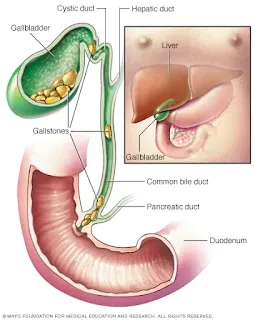Gallstones
Introduction
Gallstones are solid deposits of cholesterol or calcium salts that form in the gallbladder or the surrounding bile ducts.
- Bile is a fluid that is made and released by the liver and stored in the gallbladder. It helps with digestion by breaking down fats into fatty acids.
Gallstones may cause severe epigastric or right upper quadrant pain, acute cholecystitis, acute cholangitis, or gallstone pancreatitis. While gallbladder cancer is rare, gallstones are a risk factor for this malignancy.
- Biliary colic usually occurs following a meal as right upper quadrant (RUQ) abdominal pain with associated nausea and/or vomiting which gradually subsides.
- Acute cholecystitis usually has signs of both local inflammation (Murphy sign or right upper quadrant mass, pain, or tenderness) and systemic inflammation (fever, elevated white blood cell count, or elevated C-reactive protein).
- Ascending cholangitis (resulting from gallstones obstructing the common bile duct) classically presents with Charcot triad of fever and chills, jaundice, and RUQ abdominal pain.
- Gallstone pancreatitis' classic symptoms include nausea, vomiting, and epigastric pain radiating to the back.
Risk Factors
Risk factors for cholesterol gallstones include
- Female gender
- Family history of gallstones
- Obesity
- Rapid or cyclic weight loss
- Native American (Pima Indian) or Scandinavian ethnicity
A minority of gallstones are black pigment stones or brown pigment stones.
- Black pigment stones are related to excess bilirubin secretion in bile (as following alterations in heme metabolism).
- Brown stones are frequently secondary to biliary tract infections or biliary tract obstruction.
Symptoms
The majority of patients with gallstone are asymptomatic and will remain so throughout their lives. Of those with incidental (asymptomatic) gallstones, approximately 15-25% will become symptomatic after 10-15 years of follow up.
Patients with symptomatic uncomplicated gallstone disease typically present with biliary colic, a normal physical examination, and normal laboratory test results.
- Biliary colic is an intense, constant, dull discomfort usually located in the right upper quadrant or epigastrium that may radiate to the back (particularly the right shoulder blade). The pain is often associated with diaphoresis, nausea, and vomiting.
- Symptoms other than biliary colic have been reported in patients with gallstones, but their predictive value for the presence of gallstone disease is poor. Atypical symptoms include belching, fullness after meals/early satiety, regurgitation, abdominal distension/bloating, epigastric or retrosternal burning, nausea or vomiting, chest pain, nonspecific abdominal pain.
Typically, the evaluation begins with a transabdominal ultrasound since it is the most sensitive modality for detecting gallbladder stones.
Management
For people with asymptomatic gallbladder stones, reassure them that they do not need treatment unless they develop symptoms. Prophlactic cholecystectomy is not indicated.
For biliary colic,
- Management is focused on pain control (with NSAIDs or opioids) during an acute attack.
- Consider cholecystectomy as early as possible, but also rule out alternative causes of abdominal discomfort and consider potential complications, since 10%-40% of post-cholecystectomy patients have persistent symptoms, and almost half of patients with symptomatic gallstones may not seek repeat medical care for symptoms.
Oral litholysis with ursodiol (ursodeoxycholic acid) is indicated only for patients with small, radiolucent, noncalcified gallbladder stones and a functioning gallbladder who are unwilling or unable to have surgery.
Perform cholecystectomy for gallstone disease leading to inflammatory complications:
- within 24-72 hours for mild acute cholecystitis
- within 48 hours for mild gallstone pancreatitis
Prevention
Advise healthy lifestyle and food, regular physical activity and maintenance of an ideal body weight which may be helpful in preventing gallstones.
For adults undergoing bariatric surgery or rapid weight loss, consider ursodiol for prevention of gall stones.

This article provides valuable insights into gallstones, covering causes, symptoms, treatment, and prevention. A highly informative and useful resource!
ReplyDelete